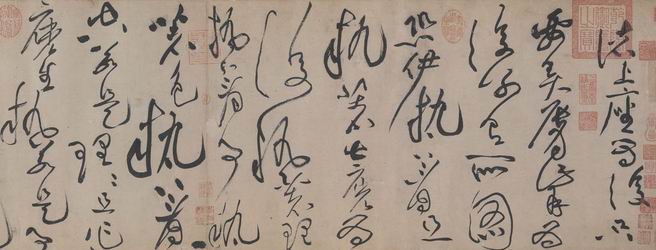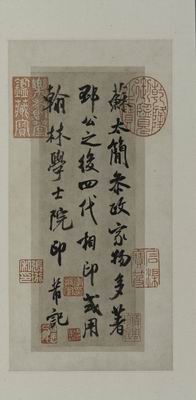Photo Source: www.shanghaimuseum.net
Compiled
by Rachel Hou

Li Jianzhong (945-1013)
Gui Zhai Tie
in running
script
Collection of the Palace Museum
Li Jianzhong (945-1013) or
Li Xitai, a native of Jingzhao (present-day Xi'an, Shanxi province) is also
known by his zi (designated name) Dezhong and his hao Yanfu
Minbo. He was a famous calligrapher of the early Northern Song dynasty.

Fan Zhongyan (989-1052)
Ode to the Taoist costume
in regular
script
Collection of the Palace Museum
Fan Zhongyan (989-1052), a
native of Wu County (present-day Suzhou, Jiangsu province), is alos known by his
zi (designated name) Xiwen. As a well-renowned politician and
litterateur of the Northern Song dynasty, he is very famous for his work
Note of Yueyang Tower in Chinese history.

Ouyang Xiu(1007-1072)
Zhuo Ai Tie
in running
script
Collection of the Palace Museum
Ouyang Xiu(1007-1072) is a
native of Luling (Ji'an, Jiangxi province). He is also known by his zi
(designated name)Yongshu and his hao Zuiweng and Liuyi Jushi (drunken
man) in the later years. With great accomplishment in Chinese calligraphy, he
initiated a new style of his own.
Cai Xiang(1012-1067)
Poems
in running script
Collection of
the Palace Museum
Cai Xiang(1012-1067), a native of Xianyou, Fujian
province, is also known by his zi (designated name)Junmo. As a
politician and calligrapher of the Northern Song dynasty, he was adept at
calligraphy in bother regular and running-cursive scripts, and crowned as one of
the "Four Great Masters of the Song Dynasty" together with Su Shi, Mi Fu and
Huang Tingjian.

Huang Tingjian (1045-1105)
Zhu Shang Zuo
in cursive
script
Collection of the Palace Museum
Huang Tingjian
(1045-1105), a native of Fenning (present-day Xiushui, Jiangxi province), is
also known by his zi(designated name) Luzhi and his hao Shangu
Daoren. As a celebrated calligrapher of the Song dynasty, he was crowned as one
of the "Four Great Masters of the Song Dynasty" together with Su Shi, Mi Fu and
Cai Xiang.

Huang Tingjian (1045-1105)
Avatamsaka Sutra
in running
script
Collection of the Shanghai Museum

Wang Shen (1048-after 1104)
Poems
in running
script
Collection of the Palace Museum
Wang Shen (1048-after
1104), a native of Taiyuan, Shanxi province, is also known by his zi
(designated name) Jinqing. Devoted to collection, poetry, calligraphy and
painting, he is noted for his inimitable calligraphy style.

Mi Fu (1052-1108)
Poems on Tiaoxi
in running
script
Collection of the Palace Museum
Mi Fu (1052-1108) is also
known by his zi (designated name)Yuanzhang and his hao
Xiangyang Manshi and Haiyue Waishi. He moved from his birthplace Taiyuan and
lived in Xiangyang. Adept at calligraphy and painting and mastering
authentication, he initiated "Mi's landscape painting" and was crowned as one of
the "Four Great Masters of the Song Dynasty" together with Su Shi, Cai Xiang and
Huang Tingjian. The poetry scroll was finished on August 8th, 1088 during the
Yuanyou reign.

Mi Fu (1052-1108)
Can Zheng Tie
in running script
Collection
of the Shanghai Museum

Xue Shaopeng (Northern Song ?-?)
Da Nian Tie
in cursive
script
Collection of the Palace Museum
Adept at calligraphy, Xue
Shaopeng shared the same fame as Mi Fu. The two were esteemed as "Mi-Xue" at
that time.

Zhao Ji (1082-1135)
The moon of the leap Mid-autumn Day Tie
in
regular script
Collection of the Palace Museum
Zhao Ji
(1082-1135), a native of Zhuo County, Hebei Province, was the emperor of the
Song dynasty who remained in power for 25 years. Having great interest in art
instead of politics, he was proficient in both calligraphy and painting. His
calligraphy is in a special script known as "slender gold script".

Zhao Gou (1107-1187)
Thousand characters after Yu Shinan
in
regular and cursive scripts
Collection of the Shanghai
Museum
Zhao Gou (1107-1187) was the Emperor Gaozong of the Southern
Song dynasty. He was adept at landscape, figure, bamboo-and-rock paintings as
well as calligraphy.
Lu You (1125-1210)
Poems
in running script
Collection of the
Palace Museum
Fan Chengda(1126-1193)
Zhong Liu Yi Hu Tie
in running-cursive
script
Collection of the Palace Museum
Fan's extraordinary
accomplishment in classical poetry contributed to his secular fame in
literati.

Zhu Xi (1130-1200)
Replying poems on the sceneries of Southern
Changsha
Zhu Xi (1130-1200), entitled as Master Kaoting, is also
known by his zi (designated name) and his hao Hui'an. He was a
native of Wuyuan, Huzhou (present-day Jiangxi province) and later moved to
Jianzhou. As an esteemed philosopher, educationist and litterateur, he was also
adept at calligraphy in a serene and elegant style.

Xin Qiji (1140-1207)
Qu Guo Tie
in running script
Collection
of the Palace Museum

Zhang Jizhi (1186-1266)
Notes of Dailou Court
in running
script
Collection of the Shanghai Museum
Donated by Liu
Jingji
Zhang Jizhi (1186-1266), a native of Hezhou (present-day
Anhui province), is also known by his zi (designated
name)Wenfu. Being proficient in calligraphy in running and regular scripts, he
is specially noted for his vigorous brushwork in the style of Yan Zhenqing.
Wu Ju (active in the 12th century)
Five paragraphed
manuscript
in running script
Collection of the Shanghai
Museum
Wu Ju (active in the 12th century) was proficient in
calligraphy and adept at painting bamboo and rocks.
Jiang Kui (ca. 1155-1235)
Colophon on Bao Mu Tie
in running
script
Collection of the Palace Museum
Jiang Kui (ca. 1155-1235),
a native of Poyang, Raozhou (present-day Boyang, Jiangxi province), was also
known by his zi (designated name) Raozhang and his hao Baishi
Daoren for living next to the Baishi Cave. As a prominent poet of the Southern
Song dynasty, he was also adept at calligraphy with vigorous brushwork. Baishi
Poetry and Xushu Pu are his representative works.
Zhao Meng Jian (1199-1264)
Poems
in running
script
Collection of the Shanghai Museum
Proficient in poetry and
calligraphy, Zhao Meng Jian (1199-1264) is also noted for his painting orchids,
bamboo and rocks. Guide to Plum Bloosom Paintings is one of his representative
works. This scroll was finished in 1254 during the Baoyou reign.

Wen Tianxiang (1236-1283)
Shang Hong Zhai Tie
in running
script
Collection of the Palace Museum
Wen Tianxiang (1236-1283),
a native of Luling, Jizhou, is also known by his zi (designated name)
and lvshan. He served as a prominent minister at the end of the Southern Song
dynasty. His poetry anthology compiled by people later is entitled Collected
Edition of Master Wenshan.



